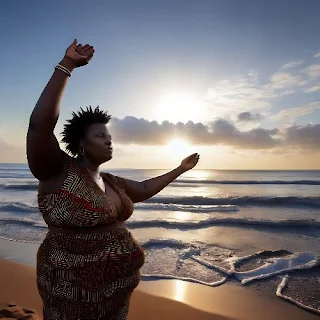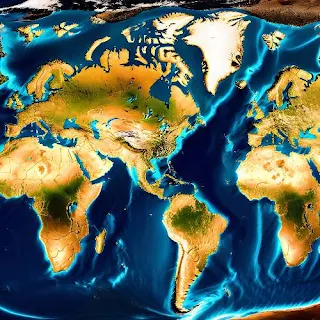Around 5% of mainland Africa is covered by water, including lakes, rivers, estuaries, bays, straits, gulfs and other bodies of water.
Africa is home to some of the world's largest rivers and lakes, such as the Nile River and Lake Victoria.
While up to 60% of Africa is classified as desert or drylands, a total volume of around 626.4 million cubic miles (2.616 billion cubic kilometers) of water surrounds Africa.
The water resources of Africa play a vital role in supporting the continent's ecosystems, as well as the lives and livelihoods of millions of people who depend on them for drinking water, agriculture, energy generation, industry and commerce.
 |
| Water is life |
Exploring the Rich Waterways of Africa: A Look at the Number and Diversity of Lakes and Rivers on the African Continent.
Two oceans border Africa.
The five major oceans of the world are the Pacific Ocean, Atlantic Ocean, Indian Ocean, Southern Ocean, and Arctic Ocean. There are two oceans that border Africa - the Atlantic Ocean on the west and the Indian Ocean on the east. The continent of Africa is bounded by these two oceans, which meet at the southern tip of Africa at Cape Agulhas.
The Atlantic Ocean washes the shores of countries such as Morocco, Western Sahara, Mauritania, Senegal, Gambia, Guinea-Bissau, Guinea, Sierra Leone, Liberia, Cote d'Ivoire, Ghana, Togo, Benin, Nigeria, Cameroon, Equatorial Guinea, and Angola.
The Indian Ocean touches the shores of countries such as Somalia, Tanzania, Mozambique, South Africa, Madagascar, Seychelles, Mauritius, Comoros, and Djibouti.
Seas that border or are adjacent to the African continent.
Seas are smaller bodies of saltwater that are partially enclosed by land. There are several seas that border or are adjacent to the African continent:
The Mediterranean Sea is located to the north of Africa and is connected to the Atlantic Ocean by the Strait of Gibraltar. It borders countries such as Morocco, Algeria, Tunisia, Libya, and Egypt.
The Red Sea is located to the northeast of Africa and separates the continent from the Arabian Peninsula. It is bordered by countries such as Egypt, Sudan, Eritrea, Djibouti, Saudi Arabia, and Yemen.
The Arabian Sea is located to the east of Africa and is part of the Indian Ocean. It borders countries such as Somalia, Yemen, Oman, and Pakistan.
The Mozambique Channel is located between Madagascar and Mozambique and is part of the Indian Ocean.
The Atlantic Ocean borders the western coast of Africa and includes several seas, such as the Gulf of Guinea, the Cape Verde Islands, and the Canary Islands. It is important to note that the definition and classification of seas can vary depending on the source and context.
Africa is known for having numerous lakes, both large and small.
Lakes are bodies of water that are surrounded by land and usually contain fresh water. Some of the largest lakes in Africa are also some of the largest in the world. Here are some examples of notable lakes in Africa:
Located in East Africa, Lake Victoria is the largest lake in Africa and the second-largest freshwater lake in the world by volume.
Lake Tanganyika also located in East Africa, it is the second-deepest lake in the world and the second-largest by volume.
Lake Malawi is located in Southeast Africa, it is the ninth-largest lake in the world by volume and is home to a diverse array of fish species.
Lake Chad, located in Central Africa, it is a shallow, freshwater lake that has been steadily shrinking in recent years due to climate change and human use.
Lake Turkana, located in Northern Kenya, it is the largest desert lake in the world and is known for its unique geology and ecology.
Lake Albert: Located on the border of Uganda and the Democratic Republic of Congo, it is the seventh-largest lake in Africa and is part of the larger Nile River system.
Lake Kivu is located on the border of Rwanda and the Democratic Republic of Congo, it is one of the African Great Lakes and is known for its unique geology and methane gas reserves.
Africa is home to many rivers.
Rivers are large bodies of water that flow through channels and empty into oceans, seas, or other rivers, some examples of major rivers in Africa:
The Nile is the longest river in the world, stretching over 6,600 km (4,100 miles) and flowing through 11 countries in North and East Africa.
The Congo River is the second-largest river in Africa by discharge and is the deepest river in the world, with depths reaching over 220 meters (720 feet).
The Niger is the third-longest river in Africa, flowing through five West African countries before emptying into the Atlantic Ocean.
The Zambezi is the fourth-longest river in Africa and flows through six countries before emptying into the Indian Ocean.
The Orange River is the longest river in South Africa and flows through Namibia and South Africa before emptying into the Atlantic Ocean.
The Limpopo River flows through southern Africa and forms part of the border between South Africa and Botswana, and later between South Africa and Zimbabwe, before emptying into the Indian Ocean.
The Senegal River flows through four West African countries and empties into the Atlantic Ocean.
Examples of major estuaries in Africa.
There are many estuaries along the coasts of Africa. An estuary is a partially enclosed body of water where fresh water from rivers mixes with salt water from the ocean. Estuaries are an important habitats for fish and other aquatic species, as well as for birds and other wildlife that depend on them for food and shelter.
Gambia River Estuary is located in the West African country of The Gambia, this estuary is an important habitat for birds and other wildlife.
St. Lucia Estuary is located in South Africa's iSimangaliso Wetland Park, this estuary is home to many species of fish, birds, and other animals.
Rufiji River Estuary located in Tanzania, this estuary is one of the largest in East Africa and is an important habitat for many aquatic species.
Zambezi River Estuary located on the border between Mozambique and Zimbabwe, this estuary is home to many fish and bird species and is an important site for ecotourism.
Senegal River Estuary is located on the border between Senegal and Mauritania and is an important habitat for birds, including flamingos and pelicans.
Congo River Estuary located in the Democratic Republic of Congo, this estuary is one of the largest in Africa and is home to many species of fish and other aquatic life.
Important bays of water in Africa.
Africa is home to many bays, which are partially enclosed bodies of water that are open to the sea on one end. Important bays in Africa:
Walvis Bay located in Namibia, this bay is known for its abundant birdlife and is an important site for commercial fishing and shipping.
Table Bay located in South Africa's Western Cape province, this bay is home to the city of Cape Town and is an important commercial and transportation hub.
Lagos Lagoon, this large lagoon is located in Nigeria and is connected to the Atlantic Ocean by a narrow channel. It is an important commercial and fishing area.
Maputo Bay is located in Mozambique, this bay is an important harbor for shipping and is home to the city of Maputo.
Dakar Bay, this bay is located in Senegal and is home to the city of Dakar. It is an important commercial and transportation hub.
Dakhla Bay located in Western Sahara, this bay is known for its strong winds and is a popular destination for windsurfing and other water sports.
There are numerous gulfs located along the coast of Africa.
A gulf is a large bay that is typically deeper and more open than a bay, and often has a narrower entrance. Here are some examples of gulfs in Africa:
Gulf of Guinea is located on the western coast of Africa, stretching from Senegal to Angola. It is an important shipping route and is home to many oil and gas reserves.
Gulf of Aden is located between Yemen and Somalia, and is an important shipping route for vessels traveling between Europe and Asia.
Gulf of Aqaba is located at the northern tip of the Red Sea, and is bordered by Egypt, Israel, Jordan, and Saudi Arabia. It is a popular destination for scuba diving and other water sports.
Gulf of Tadjoura is located in Djibouti, and is an important shipping route for vessels traveling between the Red Sea and the Indian Ocean.
Gulf of Gabès is located on the eastern coast of Tunisia, and is an important fishing area.
There are several straits located around the coast of Africa.
A strait is a narrow waterway that connects two larger bodies of water, typically separating two land masses. Here are some examples of straits in Africa:
Bab-el-Mandeb strait connects the Red Sea to the Gulf of Aden, and is located between Yemen on the Arabian Peninsula and Djibouti and Eritrea in East Africa.
Strait of Gibraltar connects the Mediterranean Sea to the Atlantic Ocean, and separates Europe from Africa. It is located between Spain and Morocco.
Mozambique Channel is a strait that separates Madagascar from mainland Africa, and connects the Indian Ocean to the south and the Mozambique Strait to the north.
Strait of Bonifacio is a strait that separates the Italian island of Sardinia from the French island of Corsica, and is located in the western Mediterranean Sea.
Strait of Sicily separates the Italian island of Sicily from the North African coast, and connects the Tyrrhenian Sea to the west with the Mediterranean Sea to the east.
Strait of Tiran is located between Egypt's Sinai Peninsula and Saudi Arabia, and connects the Red Sea to the Gulf of Aqaba.
 |
| Water is crucially important to Africa |
Water is crucially important to Africa for five major reasons; supporting ecosystems, agriculture, drinking water, industry and commerce, and energy generation:
Water is essential for supporting the diverse ecosystems found throughout Africa, including forests, wetlands, savannas, and deserts. These ecosystems are home to a wide variety of plant and animal species, many of which are found nowhere else in the world.
Water is essential for agriculture, which is a major source of livelihoods for many people in Africa. In many parts of the continent, farmers rely on rainfall to water their crops, while in other areas, irrigation systems are used to provide water to crops.
Access to clean and safe drinking water is essential for the health and well-being of people throughout Africa. Lack of access to safe drinking water can lead to waterborne diseases such as cholera, typhoid, and dysentery, which can be deadly.
Water is important for industry and commerce in Africa. Many industries rely on water for manufacturing, processing, and cooling, while ports and waterways are essential for transporting goods and commodities.
Water is also an important source of energy in Africa. Many countries in the continent rely on hydroelectric power plants to generate electricity, which can provide a reliable and renewable source of energy for homes, businesses, and industries.
More links to articles you will find thought provoking.
- Dangerous Erupting Volcanoes of Africa

- Top 20 Largest Countries in Africa

-
What is an African Proverb

- African Water Spirit Mami Wata

-
Ancestors are Guardian Angels




























